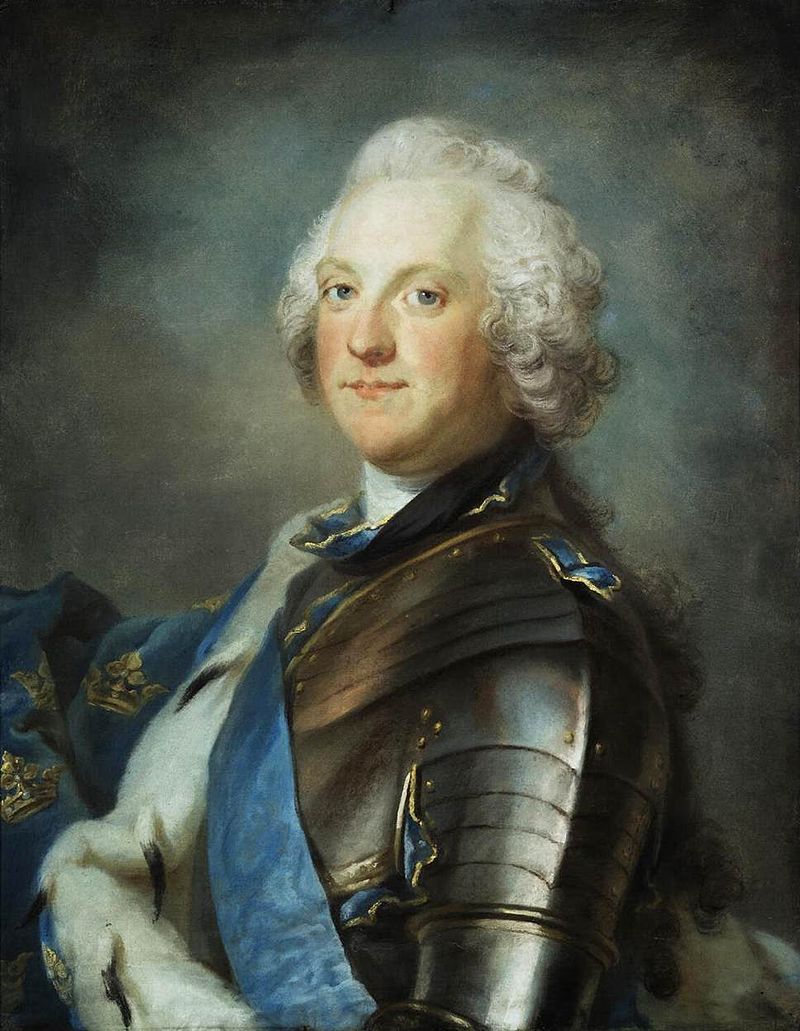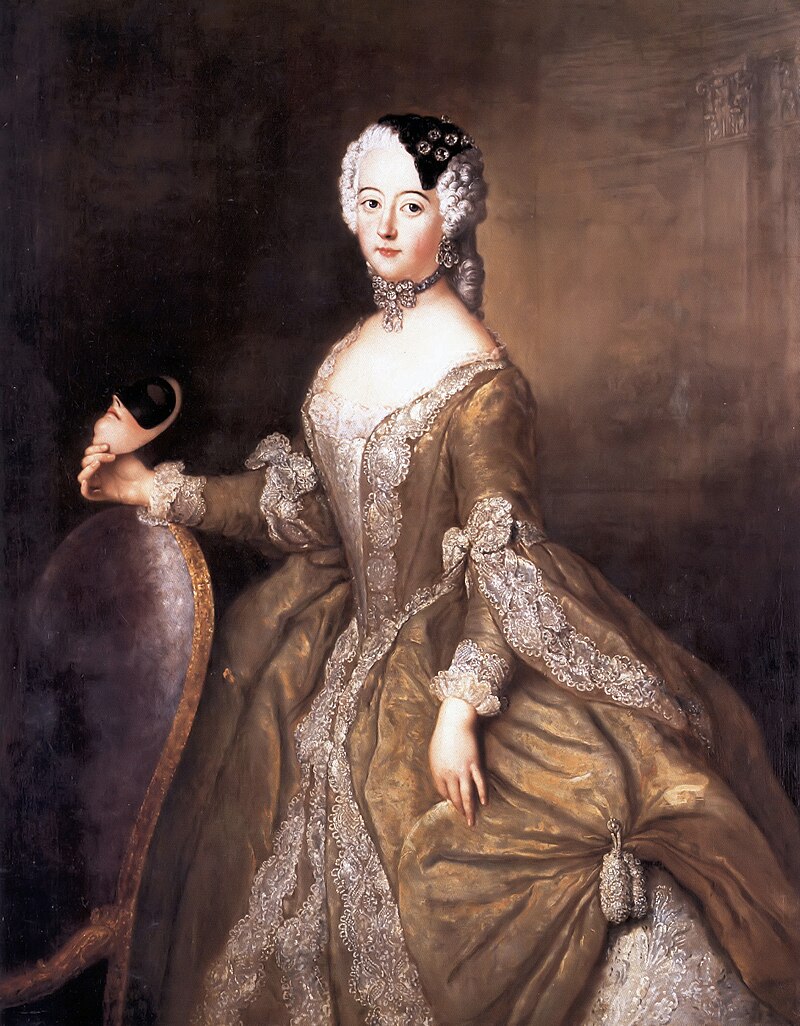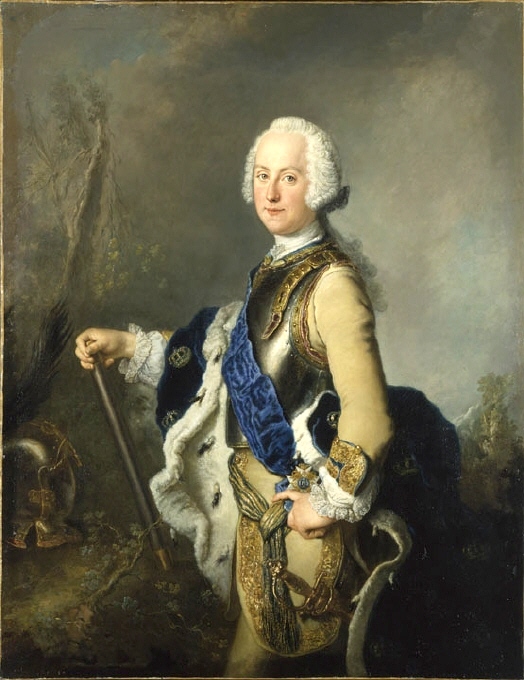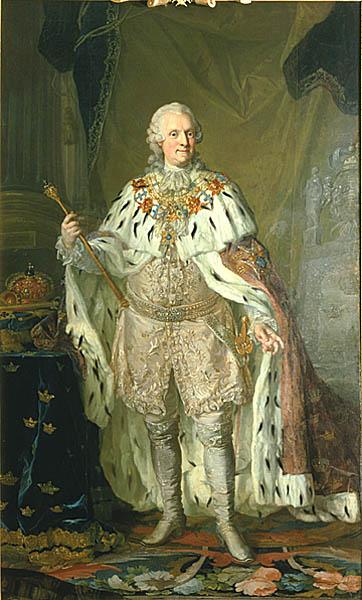by Susan Flantzer © Unofficial Royalty 2017

King Adolf Frederik of Sweden; Credit – Wikipedia
The first Swedish king of the House of Holstein-Gottorp, King Adolf Frederik was born Prince Adolf Friedrich of Holstein-Gottorp on May 14, 1710, at Gottorp Castle in Gottorp, Duchy of Schleswig, now the city of Schleswig, Schleswig-Holstein, Germany. He was the second of the six sons and the fifth of the ten children of Christian August of Holstein-Gottorp, Prince of Eutin and Albertina Friederike of Baden-Durlach.
Adolf Frederik had nine siblings, including the mother of Catherine the Great, Empress of Russia:
- Hedwig Sophie of Holstein-Gottorp (1705 – 1764), Abbess of Herford Abbey
- Karl August of Holstein-Gottorp (1706 – 1727), engaged to marry the future Elizabeth, Empress of Russia, but died before the wedding
- Friederike Amalia of Holstein-Gottorp (1708 – 1782), nun at Quedlinburg Abbey
- Anna of Holstein-Gottorp (1709 – 1758), married Prince Wilhelm of Saxe-Gotha-Altenburg, no children
- Friedrich August of Eutin, Duke of Oldenburg (1711 – 1785), married Princess Ulrike Friederike Wilhelmine of Hesse-Kassel, had three children
- Joanna Elisabeth of Holstein-Gottorp (1712 – 1760), married Christian August, Prince of Anhalt-Zerbst, had five children, including Catherine the Great, Empress of Russia
- Wilhelm Christian of Holstein-Gottorp (1716 – 1719), died in infancy
- Friedrich Conrad of Holstein-Gottorp (1718 – 1719), died in infancy
- Georg Ludwig of Holstein-Gottorp (1719 – 1763), married Princess Sophie Charlotte of Schleswig-Holstein-Sonderburg-Beck, had three children
In 1727, the seventeen-year-old Adolf Friedrich was elected Prince-Bishop of Lübeck, then a state of the Holy Roman Empire, succeeding his brother Karl August. After the death of his first cousin, Karl Friedrich, Duke of Holstein-Gottorp, in 1739, Adolf Friedrich became the administrator of the duchy for his cousin’s 11-year-old son Karl Peter Ulrich. Karl Peter Ulrich’s mother was Grand Duchess Anna Petrovna of Russia, the elder surviving daughter of Peter the Great. When his mother’s sister Elizabeth succeeded as Empress of Russia, she named her nephew her successor. Now called Peter, he married Adolf Friedrich’s niece, Princess Sophie Friederike Auguste von Anhalt-Zerbst. Emperor Peter III of Russia reigned briefly until he was deposed by his wife, who reigned as Empress Catherine II the Great.
In 1743, after the Russo-Swedish War (1741-1743) ended in Sweden’s defeat, negotiations were held with Empress Elizabeth of Russia. She agreed to restore part of Finland to Sweden if her heir’s uncle, Adolf Friedrich of Holstein-Gottorp, was made heir to the childless King Frederik I of Sweden. Thereafter, Adolf Friedrich was known by the Swedish version of his name, Adolf Frederik.

Adolf Frederik; Credit – Wikipedia
The powers that be decided that Adolf Frederik should marry either Princess Louisa Ulrika of Prussia or her youngest sister, Anna Amalia. The princesses were the daughters of King Friedrich Wilhelm I of Prussia and his wife Sophia Dorothea of Hanover, daughter of King George I of Great Britain and the only sibling of King George II of Great Britain. The Swedish ambassador to Prussia inspected both sisters and recommended Louisa Ulrika. The sisters’ brother, King Friedrich II (the Great) of Prussia, who had succeeded to the Prussia throne in 1740, described Louisa Ulrika as arrogant and divisive and recommended Anna Amalia, described as kind-hearted and more suitable. Friedrich’s real reason for recommending Anna Amalia is that he wanted a sister who would gain influence in Sweden, and he considered his youngest sister more manageable. After getting the opinion of the groom Adolf Fredrik, the Swedish government insisted on Louisa Ulrika, and King Friedrich II of Prussia gave his approval. Louisa Ulrika was taught about Sweden, converted to Lutheranism, and was advised to refrain from involvement in politics.
On July 17, 1744, Louisa Ulrika and Adolf Fredrik were married by proxy in Berlin with the bride’s brother August Wilhelm standing in for the groom. Louisa Ulrika was escorted to Sweden by the Swedish ambassador and his wife. On August 18, 1744, she was welcomed by King Frederik I at Drottningholm Palace, where the second wedding ceremony was held the same day, followed by a ball and a court reception.

Louisa Ulrika by Antoine Pesne, circa 1744; Credit – Wikipedia

King Adolf Fredrik of Sweden by Antoine Pesne; Credit – Wikipedia
Following a stillbirth, Louisa Ulrika and Adolf Fredrik had four children:
-
- King Gustav III of Sweden (1746–1792), married Sophia Magdalena of Denmark, had issue
- King Carl XIII of Sweden (1748–1818), married Hedwig Elizabeth Charlotte of Holstein-Gottorp, had two children who died in infancy
- Frederik Adolf of Sweden, Duke of Östergötland (1750–1803), unmarried
- Sophia Albertine of Sweden, Princess-Abbess of Quedlinburg Abbey, (1753–1829), unmarried

The three sons of King Adolf Frederik: King Gustav III of Sweden, Prince Frederick Adolf, and King Carl XIII of Sweden by Alexander Roslin, 1771; Credit – Wikipedia
Adolf Fredrik was introverted, gentle, and submissive, and Louisa Ulrika was pleased with him because she immediately felt secure that she was his superior. Already during their first day together, she was meddling in politics, informing Adolf Fredrik that her brother Friedrich had plans for an alliance between Sweden, Russia, and Prussia, and asked Adolf Fredrik to raise the subject with the Prussian envoy, which he agreed to do. Upon the death of King Frederik I of Sweden on March 25, 1751, Adolf Frederik succeeded to the Swedish throne. At the time of her wedding in 1744, King Fredrik I gave Louisa Ulrika the ownership of Drottningholm Palace, not too far from the Swedish capital of Stockholm. Louisa Ulrika and Adolf Fredrik continued to reside at the palace during their reign (1751–1771). In 1777, Louisa Ulrika sold Drottningholm Palace to the Swedish state. Currently, it is the home of the Swedish Royal Family.

Adolf Frederik in coronation robes; Credit – Wikipedia
During his twenty-year reign, Adolf Fredrik had no real power. The Riksdag (Swedish Parliament) held the power. Adolf Fredrik tried to change this twice, unsuccessfully. In the Coup of 1756, Queen Louisa Ulrika and her confidants planned to abolish the rule of the Riksdag and reinstate an absolute monarchy in Sweden. The attempted coup was exposed and several confidants of the royal family were executed.
During the December Crisis (1768), King Adolf Frederik refused to sign state documents and formally resigned from the throne. It was thought that this action would assemble a new Riksdag, during which reform to increase the king’s powers could be introduced. On December 20, 1768, the Riksdag was assembled and promised new reforms. King Adolf Frederik agreed to retake the throne, the crisis was averted, and the government could function again. However, the Riksdag did not assemble until 1769, and the only action it took regarding the royal house was to give it an increased allowance.
At the age of 60, King Adolf Fredrik died on February 12, 1771, at the Royal Palace in Stockholm after eating an extremely large meal and then suffering a stroke. In Sweden, he is remembered as “the king who ate himself to death.” He was buried at Riddarholmen Church in Stockholm.
This article is the intellectual property of Unofficial Royalty and is NOT TO BE COPIED, EDITED, OR POSTED IN ANY FORM ON ANOTHER WEBSITE under any circumstances. It is permissible to use a link that directs to Unofficial Royalty.
Works Cited:
- De.wikipedia.org. (2017). Adolf Friedrich (Schweden). [online] Available at: https://de.wikipedia.org/wiki/Adolf_Friedrich_(Schweden) [Accessed 17 Sep. 2017].
- En.wikipedia.org. (2017). Adolf Frederick, King of Sweden. [online] Available at: https://en.wikipedia.org/wiki/Adolf_Frederick,_King_of_Sweden [Accessed 17 Sep. 2017].
- Sv.wikipedia.org. (2017). Adolf Fredrik. [online] Available at: https://sv.wikipedia.org/wiki/Adolf_Fredrik [Accessed 17 Sep. 2017].
- Unofficial Royalty. (2017). Louisa Ulrika of Prussia, Queen of Sweden. [online] Available at: https://www.unofficialroyalty.com/louisa-ulrika-of-prussia-queen-of-sweden/ [Accessed 17 Sep. 2017].

